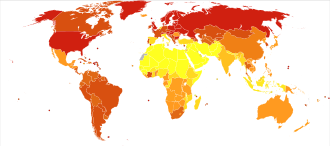Epidemiology

The World Health Organization estimates that as of 2016 there are 380 million people with alcoholism worldwide (5.1% of the population over 15 years of age). Substance use disorders are a major public health problem facing many countries. "The most common substance of abuse/dependence in patients presenting for treatment is alcohol." In the United Kingdom, the number of 'dependent drinkers' was calculated as over 2.8 million in 2001. About 12% of American adults have had an alcohol dependence problem at some time in their life. In the United States and Western Europe, 10 to 20 percent of men and 5 to 10 percent of women at some point in their lives will meet criteria for alcoholism. Estonia had the highest death rate from alcohol in Europe in 2015 at 8.8 per 100,000 population. In the United States, 30% of people admitted to hospital have a problem related to alcohol.
Within the medical and scientific communities, there is a broad consensus regarding alcoholism as a disease state. For example, the American Medical Association considers alcohol a drug and states that "drug addiction is a chronic, relapsing brain disease characterized by compulsive drug seeking and use despite often devastating consequences. It results from a complex interplay of biological vulnerability, environmental exposure, and developmental factors (e.g., stage of brain maturity)." Alcoholism has a higher prevalence among men, though, in recent decades, the proportion of female alcoholics has increased. Current evidence indicates that in both men and women, alcoholism is 50–60 percent genetically determined, leaving 40–50 percent for environmental influences. Most alcoholics develop alcoholism during adolescence or young adulthood.
Comments
Post a Comment